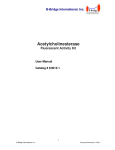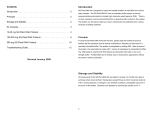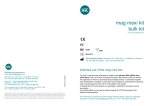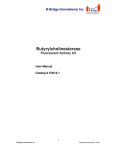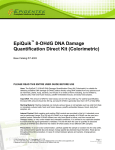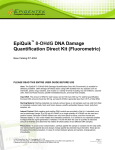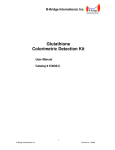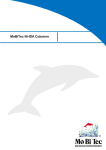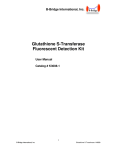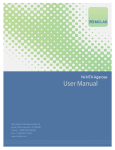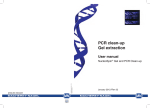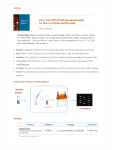Download Thiol Fluorescent - B-Bridge International, Inc.
Transcript
B-Bridge International, Inc. Thiol Fluorescent Detection Kit User Manual Catalog # K3005-1 1 B-Bridge International, Inc. Thiol 032712 TABLE OF CONTENTS Intended Use 3 Background 3 Assay Principle 3 Kit Components 3 Materials Required 4 Precautions 4 Reagent Preparation 4 Sample Preparation 5 Assay Protocol 6 Calculations 6 Typical Standard Curve: Example 7 Notice to Purchaser This product is to be used for Research Purposes Only. It is not to be used for Drug or Diagnostic Purposes, nor is it intended for Human Use. B-Bridge products may not be resold, modified for resale, or used to manufacture commercial products without the express written consent of B-Bridge International, Inc. EXCEPT AS OTHERWISE EXPRESSLY SET FORTH IN THIS USER MANUAL, B-BRIDGE DOES NOT MAKE ANY REPRESENTATION OR WARRANTIES OR CONDITIONS OF ANY KIND, EITHER EXPRESSED OR IMPLIED, WITH RESPECT TO THE PRODUCTS, OR INFORMATION DISCLOSED HEREUNDER, INCLUDING, BUT NOT LIMITED TO, THE IMPLIED WARRANTIES OF MERCHANTABILITY, FIT FOR A PARTICULAR PURPOSE, OR NONINFRINGEMENT OF THE INTELLECTUAL PROPERTY RIGHTS OF THIRD PARTIES. B-Bridge International, Inc. All Rights Reserved. 2 B-Bridge International, Inc. Thiol 032712 Intended Use The B-Bridge Thiol Fluorescent Detection Kit (cat.# K3005-1) quantitatively measure thiol groups generated or present in biological samples. This assay has been validated for samples in a number of biological buffers including Tris, phosphate, and citrate at pHs close to neutrality. Please read the complete kit insert before performing the assay. Since biologically generated free thiols, such as glutathione, and protein thiol groups, exist in different environments we suggest calibrating the amount of thiol using a suitable standard. Background Free thiols in biological systems have important roles. Oxidatively modified thiol groups of cysteine residues are known to modulate the activity of a growing number of proteins. One of the most pressing problems with this approach is to accurately determine the extent of modification of specific amino acids, such as cysteine residues, in a complex protein sample, especially in the presence of chaotropic agents such as guandine hydrochloride. The B-Bridge Thiol Fluorescent Detection Kit (Cat # K3005-1) allows users to accurately determine the extent of free thiol content in samples using a proprietary non-fluorescent Thiol Detection Reagent that is converted to a brightly fluorescent product upon reaction with the thiol in the sample. The thiol in the sample can either be one that is generated by a reaction, such as the end product of an enzymatic reaction such as glutathione, or can be the cysteine content of the protein to be measured. This assay has been tested with samples in guanidine hydrochloride concentrations up to 2M in the Assay Buffer supplied in the kit. This allows the thiol content of unfolded proteins to be accurately determined. Although we have provided a cysteine derivative as a standard that can be used to quantify free cysteines on peptides and proteins, we suggest that the assay be calibrated to a standard that chemically is as close as possible to the thiol being measured. For example, if the end user is measuring glutathione with the kit, then the assay should be calibrated to a known, validated glutathione standard preparation. Assay Principle The B-Bridge Thiol Fluorescent Detection Kit quantitatively measure thiol groups generated or present in biological samples. After mixing the sample or standard with the Thiol Detection Reagent and incubating at room temperature for a30 minute incubation, the fluorescent product is read at 510 nm in a fluorescent plate reader with excitation at 390 nm. 1. Samples and standards are pipetted into a black microtiter plate 2. The fluorescent reaction is initiated upon mixing of the sample or standard and Thiol Detection Reagent. 3. Incubate for 30 minutes and read with fluorescent plate reader at 510 nm with 390 nm excitation. Kit Components Black Microtiter Plate – 96 Wells 1 plate N-Acetylcysteine Standard (100,000 nM in stabilizing solution) 220 µL Thiol Detection Reagent 2 vials Dry DMSO 4 mL 2X Assay Buffer 60 mL Plate Sealer 1 each Store all components at 4°C until expiration date of kit, expect DMSO which will freeze. Store DMSO at room temperature. 3 B-Bridge International, Inc. Thiol 032712 Materials Required But Not Supplied Deionized or distilled water Repeater pipet with disposable tips capable of dispensing 25 µL. Polypropylene disposable test tubes for making dilutions. Fluorescence 96 well plate reader capable of reading fluorescent emission at 510 nm, with excitation at 390 nm. Please contact your plate reader manufacturer for suitable filter sets. Set plate parameters for a 96-well Corning Costar 3686 plate. Software for converting raw relative fluorescent unit (FLU) readings from the plate reader and carrying out four parameter logistic curve (4PLC) fitting. Contact your plate reader manufacturer for details. Precautions As with all such products, this kit should only be used by qualified personnel who have had laboratory safety instruction. The complete User Manual should be read and understood before attempting to use the product. Dimethyl sulfoxide (DMSO) is a powerful aprotic organic solvent that has been shown to enhance the rate of skin absorption of skin-permeable substances. Wear protective gloves when using the solvent especially when it contains dissolved chemicals. The Detection Reagent should be stored at 4°C in the desiccator. Allow desiccator to warm to room temperature prior to opening. ThioStar will react with strong nucleophiles. Buffers containing the preservatives sodium azide, Proclin™ and Kathon™ will react with the substrate. In all cases, please consult your institution’s safety procedures for working with hazardous chemicals. Reagent Preparation Allow the kit reagents to come to room temperature for 30 minutes. We recommend that all standards and samples be run in duplicate to allow the end user to accurately determine thiol concentrations accurately. Ensure that all samples have reached room temperature and have been diluted as appropriate prior to running them in the kit. Buffer Preparation The Assay Buffer Concentrate should be diluted 1:2 by taking one part of the Concentrate and adding one part of deionized water prior to use. It is stable for up to 3 months when stored at 4°C. Thiol Detection Reagent Allow to warm to room temperature prior to opening. Remove the vial of ThioStar Reagent from the desiccator and add 1.5 mL of the provided DMSO to the vial. Vortex thoroughly. Store any unused reconstituted Detection Reagent at 4°C in the desiccator and use within 2 weeks. Standard Preparation Label eight polypropylene test tubes as #1 through #8. Pipet 900 µL of Assay Buffer into tube #1 and 500 µL into tubes #2-#8. Carefully add 100 µL of the standard stock solution to tube #1 and vortex completely. Add 500 µL of tube #1 to tube #2 and vortex completely. Repeat these serial dilutions for tubes #3 through #8. The concentration of N-Acetylcysteine in tubes 1 through 8 will be 10,000, 5,000, 2,500, 1,250, 625, 312.5, 156.25 and 78.125 nM. Use all Standards within 2 hours of preparation. 4 B-Bridge International, Inc. Thiol 032712 Std 1 900 Std 2 500 Std 3 500 Std 4 500 Std 5 500 Std 6 500 Std 7 500 Std 8 500 100 - - - - - - - Std 1 (µl) - 500 - - - - - - Std 2 (µl) - - 500 - - - - - Std 3 (µl) - - - 500 - - - - Std 4 (µl) - - - - 500 - - - Std 5 (µl) - - - - - 500 - - Std 6 (µl) - - - - - - 500 - Std 7 (µl) - - - - - - - 500 10,000 5,000 2,500 1,250 625 312.5 156.25 78.125 Assay Buffer (µl) N-Acetylcysteine Standard (µl) Final Concentration (nM) Sample Preparation All samples should be diluted at least 1:10 in the Assay Buffer prior to analyzing. All samples and buffers should be free of excess thiols and reducing agents such as ß-mercaptoethanol, TCEP, or DTT. This assay has been validated for samples in guanidine hydrochloride solutions up to 4M when these samples are diluted with an equal volume of Assay Buffer. The effect of GuHCl concentration is shown below. 5 B-Bridge International, Inc. Thiol 032712 Assay Protocol 1. Pipet 100 µl of samples, Assay Buffers as the blank, or standards into wells in the black microtiter plate. 2. Pipet 25 µl of the Thiol Detection Reagent to each well using a repeater or multichannel pipet. 3. Gently tap the sides of the plate to ensure adequate mixing of the reagents. 4. Cover the plate with the plate sealer and incubate at room temperature for 30 minutes in the dark. 5. Set plate parameters for a 96-well Corning Costar 3686 plate (see table below). Read the fluorescent signal from each well in a plate reader capable of reading the fluorescent emission at 510 nm with excitation at 370-410 nm. Please contact your plate reader manufacturer for suitable filter sets. 6. Use the plate reader’s built-in 4PLC software capabilities to calculate thiol concentrations for each sample. Plate Dimensions (in mm) Well Depth Plate Length Plate Width A1 Row Offset * A1 Column Offset † 10.54 127.8 85.5 11.2 14.3 * A1 Row Offset is distance from top of plate to center of well A1 † A1 Column Offset is distance from left edge of plate to center of well A1 Calculations Average the duplicate FLU readings for each standard and sample. Create a standard curve by reducing the data using the 4PLC fitting routine on the plate reader, after subtracting the mean FLUs for the zero standard. The sample concentrations obtained should be multiplied by the dilution factor to obtain neat sample values. 6 B-Bridge International, Inc. Thiol 032712 Typical Standard Curve 7 B-Bridge International, Inc. Thiol 032712







